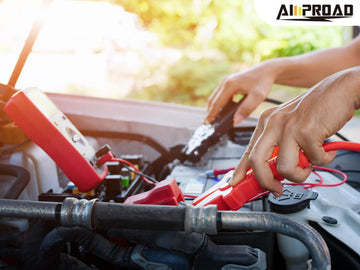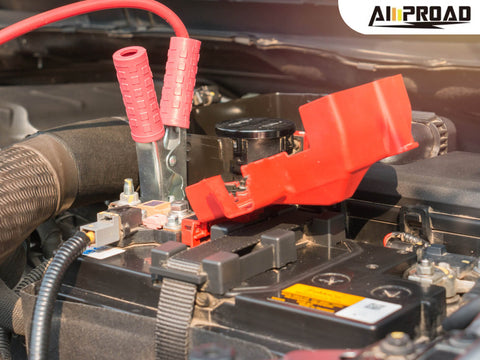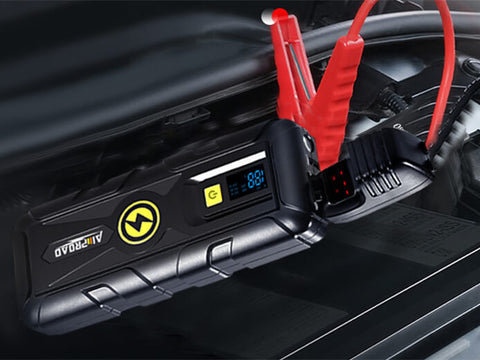
Your portable jump starter is a lifesaver when your car battery dies, but is it still safe to use? Over time, jump starters can degrade, posing potential hazards. It's essential to regularly inspect your jump starter for signs of wear and tear, such as frayed cables or corroded connectors. Additionally, check the battery status and ensure it holds a charge effectively. If you notice any issues or have concerns about the safety of your jump starter, it's best to replace it promptly to avoid any accidents or damage to your vehicle. Remember, safety always comes first when dealing with electrical equipment. Here's an exploration to help you determine if your trusty jump starter is still up for the task.
Signs Your Jump Starter Might Need Replacing
Your jump starter is a vital tool for emergencies, but over time, it can wear out or become ineffective. Here are some signs indicating it might be time for a replacement:
- Age: Most jump starters have a lifespan of around 3-5 years. If yours is older than that, especially if accompanied by other signs of wear and tear, it's wise to consider a replacement. As jump starters age, their internal components degrade, reducing their effectiveness.
- Physical Damage: Inspect your jump starter for visible damage such as cracks, bulging, or leaking casings. These signs suggest internal damage that could compromise its safety and performance. If you notice any physical damage, it's crucial to replace the jump starter promptly to avoid potential hazards.
- Reduced Cranking Power: One of the primary functions of a jump starter is to provide sufficient power to crank your car's engine. If you find that your jump starter struggles to start your vehicle, even after a full charge, it could indicate that it's nearing the end of its lifespan. Diminished cranking power suggests internal issues with the jump starter's battery or components.
- Battery Indicator Issues: Many modern jump starters come equipped with battery indicators to display the charge level. However, if you notice that the indicator is faulty and doesn't accurately reflect the charge level, it can be problematic. A malfunctioning battery indicator can lead to unexpected failures or safety risks during use. If your jump starter exhibits erratic behavior with its battery indicator, it's a clear sign that it needs replacing.
Regularly inspect your jump starter for these signs of wear and tear. If you identify any of these issues, it's essential to replace your jump starter promptly to ensure you have a reliable tool in emergency situations. Remember, investing in a new jump starter is a proactive step to maintain your safety and preparedness on the road.
Safe Storage and Maintenance Tips for Your Jump Starter
- Store It Cool and Dry: Extreme temperatures can damage the internal battery of your jump starter. Avoid storing it in direct sunlight or in very hot or cold environments.
- Keep It Charged: Even when not in use, it's a good idea to periodically recharge your car booster pack to maintain battery health. Consult your jump starter's manual for recommended charging intervals.
- Clean the Terminals: Corrosion on the jumper cable clamps can hinder performance. Clean the clamps regularly with a wire brush to ensure a good connection.
Regularly inspect your jump starter for these signs of wear and tear. If you identify any of these issues, it's essential to replace your jump starter promptly to ensure you have a reliable tool in emergency situations. Remember, investing in a new jump starter is a proactive step to maintain your safety and preparedness on the road.
Testing Your Jump Starter
Maintaining your jump starter in optimal condition is crucial for its effectiveness during emergencies. Here are some steps to test your jump starter:
Visual Inspection: Before each use, visually inspect your jump starter for any signs of damage, such as cracks, bulges, or leaking fluids. Pay close attention to the casing and connectors. If you notice any physical damage, refrain from using the jump starter and consider replacing it.
Check the Charge Level: Ensure your jump starter is fully charged before attempting to use it. Most jump starters come with LED indicators or digital displays that show the charge level. If the charge level is low, recharge the jump starter according to the manufacturer's instructions. It's recommended to periodically recharge your jump starter, even if it hasn't been used recently, to maintain its charge.
Load Test (Optional): For a more comprehensive assessment of your jump starter's performance, you can conduct a load test using a voltmeter. This test measures the jump starter's output voltage under load, simulating the conditions when jump-starting a vehicle. To perform a load test, connect the voltmeter to the jump starter's output terminals and crank the engine. The voltmeter will display the voltage drop during cranking, indicating the jump starter's cranking power. Refer to your jump starter's manual or consult a qualified technician for proper load testing procedures.
Regularly testing your jump starter ensures that it's ready for use when needed. By conducting visual inspections, checking the charge level, and optionally performing a load test, you can verify the reliability and effectiveness of your jump starter, providing peace of mind during roadside emergencies. If you encounter any issues during testing or notice signs of deterioration, consider replacing your jump starter to ensure your safety on the road.
When in Doubt, Replace It Out

When it comes to the safety and reliability of your jump starter, it's best to prioritize caution. If you have any doubts about the functionality or safety of your jump starter, it's wise to replace it promptly.
A faulty jump starter not only risks leaving you stranded with a car that won't start but can also pose safety hazards. Over time, jump starters can degrade due to wear and tear, potentially compromising their performance.
If you've noticed any signs of damage, such as cracks, bulging, or leaking fluids, or if your jump starter struggles to hold a charge or provide sufficient cranking power, it's a clear indication that it's time for a replacement.
Investing in a new jump starter ensures that you have a reliable and effective tool at your disposal for jump-starting your vehicle during emergencies. Consider the AMPROAD portable jump starter for a versatile and dependable option that offers peace of mind on the road.
Remember, preventive maintenance and regular inspections are key to identifying potential issues with your jump starter early on. By staying proactive and replacing your jump starter when necessary, you can avoid the inconvenience and safety risks associated with using a faulty or unreliable device.
Maintaining Your Portable Jump Starter
Maintaining your portable jump starter is essential to ensure its safety and reliability whenever you need to jump start the car, of course, the premise is that you know how to boost a car. Regularly inspect it for any signs of damage, such as cracks or leaks, and ensure it has a full charge before use. Consider performing a load test periodically to assess its cranking power accurately.
Additionally, store your jump starter in a cool, dry place away from direct sunlight and extreme temperatures, which can degrade its performance over time. Avoid exposing it to moisture or corrosive materials that could damage its internal components.
By following these simple tips, you can prolong the lifespan of your jump starter and ensure it's always ready to assist you when you need to boost a car. Remember, investing in proper maintenance now can save you from the hassle of dealing with a malfunctioning jump starter later on, providing you with peace of mind and confidence on the road.
FAQs / People Also Ask
How do I know if my portable jump starter is still safe to use?
Look for signs of physical damage such as cracks or leaks in the casing.
Check if the jump starter struggles to start your car even after a full charge.
Monitor the battery indicator for accuracy in reflecting the charge level.
Can I test my jump starter before using it?
Yes, perform a visual inspection for any visible damage.
Ensure the jump starter is fully charged before attempting to use it.
Optionally, conduct a load test using a voltmeter for a more thorough assessment.
What should I do if I suspect my jump starter is faulty?
When in doubt, it's safer to replace the jump starter.
A faulty jump starter not only fails to start your car but can also pose safety risks.
How long does a portable jump starter typically last?
Most jump starters have a lifespan of around 3-5 years.
Consider replacing it if it's older or showing signs of wear and tear.
Are there any specific maintenance tips for portable jump starters?
To maintain your portable jump starter's reliability, perform regular inspections to check for any damage and ensure it's fully charged before each use. Adhere to the manufacturer's guidelines for proper storage and maintenance practices to prolong its lifespan. Additionally, consider investing in a quality jump starter like the AMPROAD portable jump starter, known for its reliability and performance. Choosing a reputable brand ensures that you have a dependable tool for jump-starting your vehicle whenever needed, providing peace of mind on the road.



